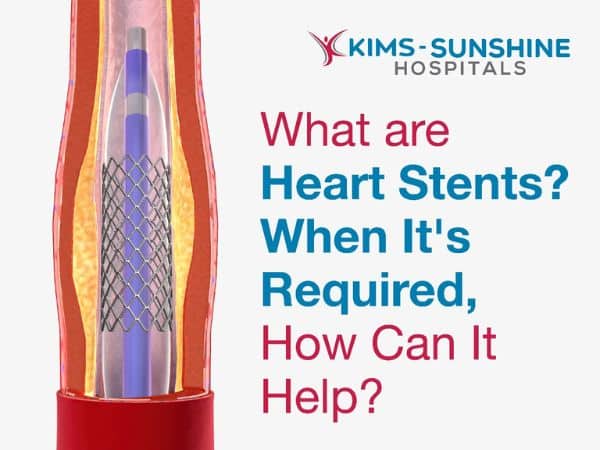
What are Heart Stents? When It’s Required, What Errors to Avoid, How Can It Help? | KIMS-SUNSHINE Hospitals
By Dr. D. Lingaswamy,MD (Paediatrics), DM (Paediatric Cardiology)
 Hey there! Have you ever wondered what a heart stent is and how it can make a real difference in your life? We are here to explain it all in a simple and efficient way.
Hey there! Have you ever wondered what a heart stent is and how it can make a real difference in your life? We are here to explain it all in a simple and efficient way.
What is a Heart Stent?
A heart stent is like a tiny, flexible tube. It’s placed inside a clogged or narrow heart blood vessel to help it stay open. Sometimes, doctors use stents with a special technique called angioplasty, which is like blowing up a balloon to widen the blocked area.
When Do You Need a Heart Stent?
If you have something called coronary artery disease (CAD), a stent can be a game-changer for you. CAD happens when the pipes that carry blood to your heart get blocked with gunk. This can lead to chest pain, heart attacks, and other troubles. But it’s not just CAD; heart stents can also help folks with:
- Cardiomyopathy – a heart condition that makes your heart muscle weaker.
- Congenital heart disease – heart problems you’re born with.
- Heart attacks – when a pipe in your heart gets totally blocked.
- Peripheral artery disease (PAD) – when the blood vessels in your legs and feet get clogged.
How Does a Heart Stent Help?
Now, here’s the magic! A heart stent opens up those blocked blood valves, so blood flows smoothly to your heart. This can make chest pain and shortness of breath disappear. Plus, it lowers the chance of a heart attack or stroke.
Are There Any Risks?
Like any other surgical procedure, heart stents also come with a few risks:
- Sometimes, there can be a little bleeding where they put the stent or inside the blood vessel.
- Occasionally, stents might cause blood clots, which could lead to a heart attack or stroke.
- And, though it’s rare, a few people might be allergic to the stuff stents are made of.
- There’s also something called restenosis, which is when the blood pipe gets narrowed again after the stent is put in.
However, these risks can be minimized or eliminated completely if done by expert cardiologists at one of the Best Cardiology Hospital in Hyderabad.
Getting Ready for a Heart Stent
Before the stent procedure begins, your doctor will tell you what to do:
- You’ll need to fast (no eating) for a few hours before the stent works.
- They might give you some special medicine.
- And you should steer clear of smoking and alcohol.
What Happens After the Stent?
After the stenting procedure, you’ll be kept under observation in a recovery room. Once you’re free to go home, don’t forget to:
- Take your medicine to stop blood clots.
- Get moving and exercise regularly.
- Eat healthy for your heart.
- And, of course, say no to smoking and alcohol.
Choosing the Right Heart Heroes
When it comes to keeping your heart in its best health, it’s crucial to pick the right cardiologists at the Best Heart Hospital In Hyderabad, KIMS-SUNSHINE Hospital. The hospital stands out as one of the leaders in cardiac care in the city. Their expertise extends to all types of cardiac problems, ensuring that patients receive top-notch care at their Cardiology Hospital Near You.
Avoiding Common Slip-Ups in Heart Recovery
Now, let’s chat about a few things to avoid as you bounce back from a heart adventure:
- Don’t forget your physical therapy; it’s like a workout for your heart.
- Take it slow; don’t push yourself too hard after a heart procedure.
- If your legs and feet feel weird or swollen, don’t ignore it; it could be a blood clot. Tell your doctor pronto.
- Keep up with your medicine, even if you feel great.
- Stick to a heart-healthy diet; it’s like a shield for your heart.
In Conclusion
Heart stents are a safe and effective treatment for many types of heart disease. If you are considering a heart stent procedure, be sure to talk to your doctor about the risks and benefits. And, if you choose to have a heart stent procedure, be sure to follow your doctor’s instructions carefully to ensure a successful recovery.
For a life free from heart-related issues, consult with cardiologists at one of the Best Cardiac Hospital in Hyderabad, KIMS-Sunshine Hospitals, Secunderabad. The Cardiac Hospital Near You offers exemplary medical guidance and assists in making informed decisions about your heart health.
FAQs
Q. What are the symptoms of a blocked or narrowed coronary artery?
A. The most common symptoms of a blocked or narrowed artery are shortness of breath, chest pain, fatigue, dizziness, heart palpitations. If you experience any of these symptoms, rush to the nearest cardiology hospital near you. In case of emergencies call 8008 108 108.
Q. What are the benefits of heart stent surgery?
A. Heart stenting can help in improving the flow of blood to the heart, it can reduce the risk of heart attacks and heart problems and also relieve various symptoms of coronary artery disease.
Q. What is the recovery time for heart stent surgery?
A. After a stenting procedure, most patients will be able to go home within 1-2 days after surgery. However, it is important to take your doctor’s instructions seriously and follow them during your recovery. The recovery instructions may include taking medicines to prevent blood clots, regular exercise, and eating a healthy diet.
Q. What is the best heart hospital in Hyderabad?
A. KIMS-Sunshine Hospitals, Secunderabad is one of the best heart hospital in Hyderabad. The hospital has a team of experienced and skilled cardiologists who offer a variety of emergency cardiac care and heart care services. Call 040 – 4455 0000 to book an appointment with expert cardiologists at their cardiology hospital near you.
Q. What does a heart stent look like?
A. The heart stent looks like a tiny mesh tube. It is made of metal or plastic and has an outer coating that helps to prevent blood clots from forming inside. This tube is inserted into the blocked coronary artery to open it up and restore normal blood flow to the heart.
Q. How is a heart stent inserted?
A. Heart stents are usually inserted through a small incision in the groin. A tiny catheter tube is then inserted into the artery and sent to the blocked area. The stent is then deployed and expanded to widen the artery space and restore normal blood flow.






